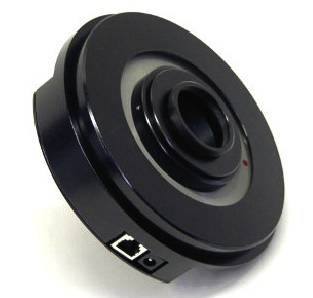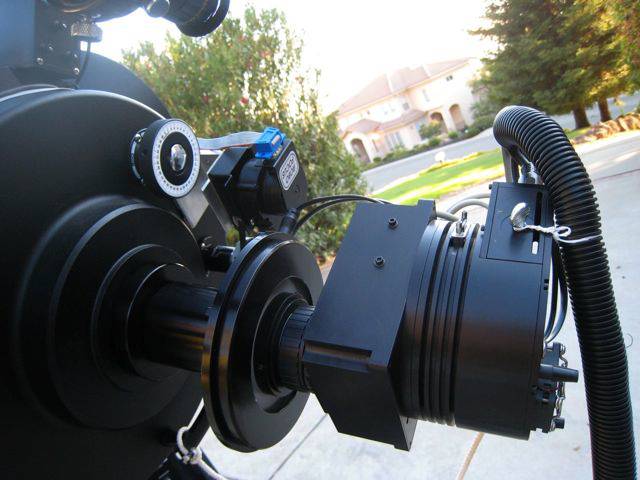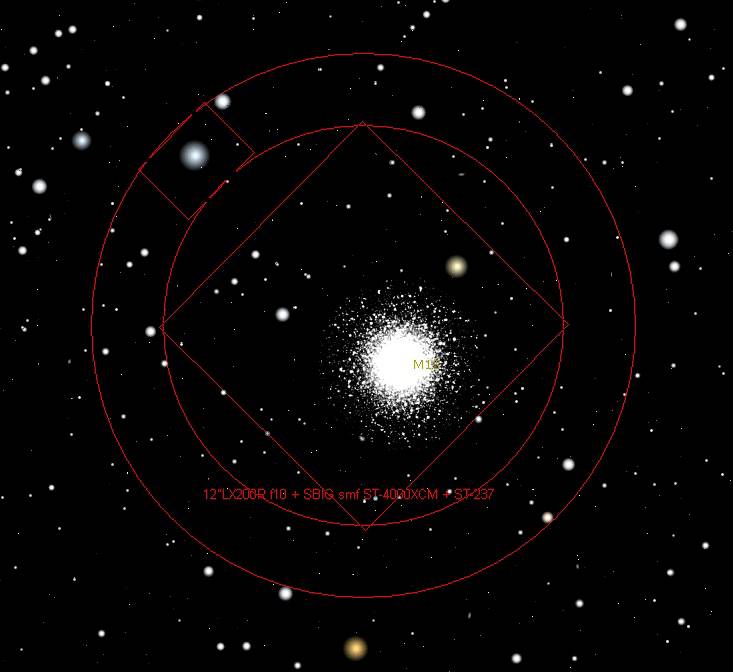

The Pyxis is a device that can rotate the CCD camera. This is done primarily to center a selected guide star on the guide chip of the camera, and also to obtain better framing. The SBIG CCD cameras are available with 2 CCD chips: one for imaging, and a smaller one for guiding (SBIG holds a patent on this configuration). With a longer focal length scope, like the 12" LX200 (FL=3260 mm), it is not easy to find a bright guidestar (as the field-of-view is so small - only tens of arcminutes). A bright guidestar is desirable, so that the guide exposure can be made shorter, and corrections therefore made faster. In fact, if the SBIG adaptive optics systems (AO-8 or larger format AO-L) are used, they can make corrections up to 30 times per second (for the AO-8; the AO-L is slower, as it has a larger optical element to move). If filters are used, then an even brighter guide star is needed. While it may be unlikely to find a really bright guidestar just above the main imaging chip (where the guide chip is located), when the image is framed as you would like it, it is much more likely to find a bright guidestar SOMEWHERE in a circle around the main chip. By rotating the camera, the guide chip can be put in a position to see the bright guidestar, without changing the centering of the main object to be imaged. Another reason to have a camera rotator is to frame the main image better. As the primary goal of most amateur astro-imaging is to make a "pretty picture" - i.e., combine science with art (or "artistic application of science") - it is very important to be able to frame the image well. While the image could be cropped in whatever angle or size is desired, this will result in a smaller image - not taking advantage of the original field-of-view of the camera/scope combination. By using the Pyxis, the image can be perfectly framed - however, there is obviously a trade-off between desired framing and available guide stars at that position angle. CCDNavigator, a planning program that enables creation of target lists and imaging plans for CCDAutoPilot, now (in version 2) has a neat interactive routine for selecting position angle, based on the available guidestars - one only has to click to see various framings of the main chip and guide stars which can be used at each position angle. The final selection goes into an imaging plan that is imported into CCDAutoPilot. The photo below shows the Pyxis mounted in the image train, turning an ST-4000XCM camera and AO-8 adaptive optics unit: |
 |
The image below (TBD) shows the field of view indicator in TheSky, which contains 1) a square showing location of the main imaging chip (as the KAI-2020 chip is square), 2) a smaller rectangle showing the location of the [TC-237] guide chip, and 3) an annular ring (two red circles) showing the various positions that the guide chip can take, depending on rotation of the entire camera using the Pyxis. You can see in the image below that the camera has been rotated so that the very bright guidestar is centered in the guide chip. In this case, the target is a globular cluster, so framing is not quite as important. However, in order to get the guidestar on the guide chip, it was necessary to offset the main target (and later crop the image around the globular cluster). This is a good example of the trade-off between framing and finding a good guidestar. With a larger camera (such as the STL), there is even a larger field-of view, so the concentric circles are bigger, and have more annular space between them - i.e., providing an even greater chance of finding a guidestar. |
 |
Using a rotator can be VERY confusing! First, one must determine which direction of rotation results in increasing position angle ("PA"). The Pyxis controller can be set for clockwise or counterclockwise, and this must be correct for the imaging software to turn the camera in the right direction to match the FOV indicator in TheSky. Not only that, but the software must be calibrated, so that it knows the initial PA angle ("camera angle") of the system - which is usually offset from the Pyxis internal rotation angle. The calibration can be done by plate solving (e.g., using CCDSoft and TheSky or MaximDL and Pinpoint) to find the actual PA. However, even more confusion arises because the rotation angle depends on whether the scope is facing East or West; in fact, using a German Equatorial Mount ("GEM"), the camera is rotated 180 degrees in going from East to West, so that the image remains oriented the same (if the rotator were not used, then the image would be "upside down" after the meridian flip; this may be OK, if the images are rotated and stacked later, but there would also usually be no bright guide star on the guide chip unless the camera is rotated! There's a lot to think about ... |